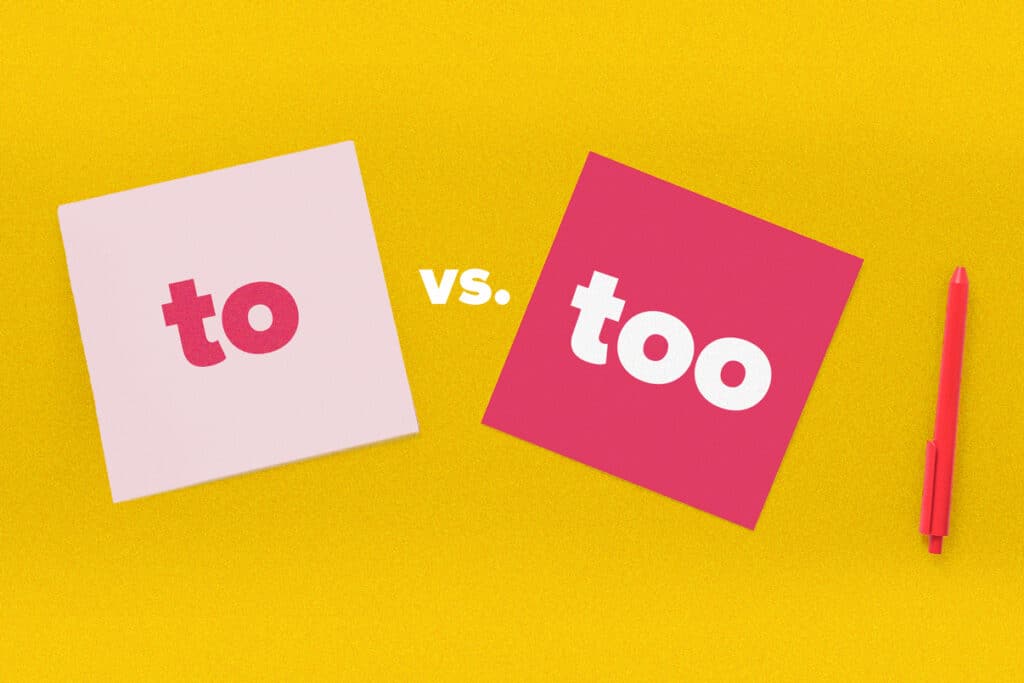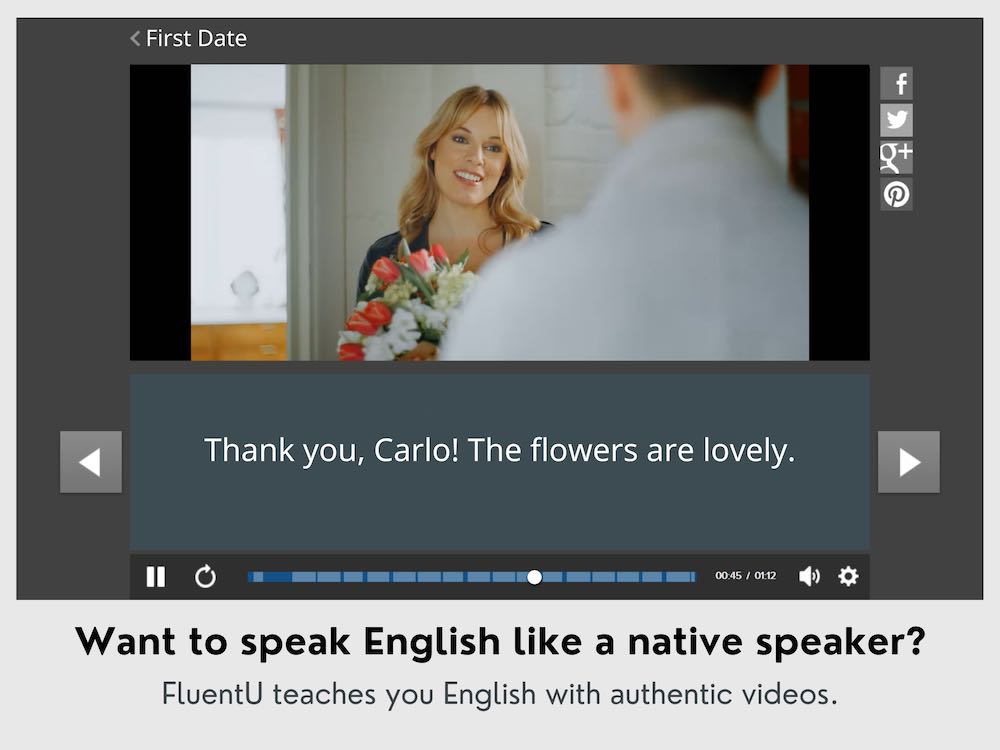
The Difference Between To and Too
Knowing the difference between to and too is important because they are both very common words in English.
They can be easily confused in English because they sound and look alike. Whether in casual conversation, online posts or even essays, this happens a lot.
This post will help you to understand the difference between these two words, plus when to use them. You’ll also learn a few tips to help you practice!
Let’s get started.
Contents
- The Difference Between “To” and “Too”
- Uses of “To” and “Too”
- Synonyms for “To” and “Too”
- How to Pronounce “To” and “Too” in Casual Speech
- “To” and “Too” Practice Quiz
- And One More Thing...
Download: This blog post is available as a convenient and portable PDF that you can take anywhere. Click here to get a copy. (Download)
The Difference Between “To” and “Too”
To shows direction, movement toward or range between people, places, or things. It’s a preposition (a connecting word that shows a relationship between other words) and can also be part of phrasal verbs (e.g. “get back to you”) or infinitives (e.g. “to begin”).
Too is used when something is additional (“me, too!”) or excessive (“too spicy”). Too is an adverb (a descriptive word that modifies another word, usually a verb).
When pronounced properly, these words sound exactly the same!
And sometimes they can also get mixed up with two which is always a number (the one which comes after one and before three!) You use it to indicate the quantity of something. For example: “I have two apples.”
Uses of “To” and “Too”
1. “To” as a preposition
As we mentioned, to is a preposition that shows a relationship between words. There are a lot of ways you can use to as a preposition, but its most common meanings are related to movement or space between things.
Let’s look at some examples of how it can be used!
To show direction or movement towards something. You also use to to indicate a place of arrival. For example:
I’m going to the restaurant right now.
She’s driving to the park this afternoon.
To show ranges of time or amounts. You can use to when you want to give a length of time or distance between a certain start and end point. You also use to when giving an estimate between one number and another. For example:
The ride will be open from 10 a.m. to 2 p.m.
The road is blocked from Oak Street to Elm Street.
To show possession, since we say that an object belongs to a person. Another related use is attachment, which can be between objects or people. For example:
This bag belongs to my sister.
I’ve attached the report to this email.
To show similarity. You can also use to for proportions. For example:
This movie is too similar to the other romantic comedies I’ve watched before.
The ratio of sugar to flour in this recipe is 1 to 2.
To show degree. This is usually meant for extreme situations. For example:
The weather is cold to the bone.
She studied to the point of exhaustion.
2. “To” as part of a phrasal verb
Sometimes to is part of a phrasal verb, such as “look up to” or “get back to.”
We know that verbs are words that indicate actions. But phrasal verbs are used with other words and have a different meaning than the same words by themselves.
Here’s an example:
I’m sorry I forgot about our plans. I’ll make it up to you.
“To make it up to someone” is a phrasal verb that means to do something good to account for (balance out) something bad that you did.
Here’s another example:
Sorry, this is a bad time! Can I get back to you?
You might say this to someone while talking on the phone. In both examples, you can see there’s a kind of movement. When I say that I will get back to you, “getting back” is something that I will do in your direction.
Since the preposition to is so common, you’ll find many more ways to use it.
3. “To” as part of an infinitive
An infinitive is the unconjugated, base form of a verb. In English, infinitive verbs start with the preposition to followed by the main verb. Here are some examples:
To show
To dance
To study
Besides being the unconjugated form of a verb, infinitives can also be used in sentences. Infinitive verbs are often paired with conjugated verbs:
I want to show you something.
In this sentence, the first verb “want” is conjugated for the first person singular, or “I.” Next is the infinitive “to show,” which isn’t conjugated. This expresses that showing you something is what I want.
There are a lot of examples of the word to in Tracy Chapman’s “Fast Car” (click here to listen). It’s a song that expresses a lot of ideas about movement and direction and also makes use of infinitives:
I want a ticket to anywhere (movement towards a place)
Managed to save just a little bit of money (infinitive following a conjugated verb)
We won’t have to drive too far
This last example uses the expression “to have to [do something],” which means an action that is required or needs to happen.
You can see that it also contains the word too, which we’ll look at next.
4. “Too” meaning “also”
One of the most common meanings of too is “also” or “additionally.”
It’s super easy to spot when to use too when it means “additionally.” You just need to think if you can use the word “also” in a sentence. For example, you could say, “Are they also coming?”
But the nice thing about too is that it usually falls at the end of sentences, making it easier to use and notice.
Here are some examples:
I want to show you my new tattoo, too.
Are they coming, too?
She’s wearing her red T-shirt, too.
5. “Too” meaning “excessively”
If used before an adjective or adverb in a sentence, it’s expressing the idea of excess, or “more than is needed.”
If my car is “too fast,” it has excessive speed. If the inside of my car is “too hot,” it has excessive heat.
The song “Nobody” by Mitski (click here to listen) has a good example of both uses of too together. At the beginning of the song, she sings:
Venus, planet of love
Was destroyed by global warming
Did its people want too much, too?
Did its people want too much?
The second too in the third line has the meaning of “also.” So the sentence means: “Did its people want more than they needed, also?” This song also contains several examples of to, making it perfect for practicing both words.
Here are some more examples of too in general:
Do your friends think you’re too loud?
When you’re at parties, do you talk too much?
Especially when you drink too many cocktails?
Has anyone ever told you that you, yourself, are just too much?
Synonyms for “To” and “Too”
These words are synonyms: words or phrases that share a meaning. It may help you understand to and too if you know other ways to say the same things!
To has very few exact synonyms, but other prepositions with similar uses include:
- Toward/towards
- Into
- Until/till
- Through
- On
- Upon
- Against
Too has the synonyms:
- Also
- Additionally
- Excessively
- As well
- In addition
- Furthermore
- Overly
- Exceptionally
How to Pronounce “To” and “Too” in Casual Speech
Now that you know the main differences between to and too, it’s important to learn how native speakers pronounce them.
In “correct” English, to and too are both pronounced with an “ooh” sound, but in casual speech, there is a difference:
To often becomes “tuh” and is blended with other words.
Too usually keeps its “ooh” sound.
In some accents, the vowel might be dropped entirely, such as in phrases like:
It’s time t’go. (It’s time to go.)
“To” blended with other words
In casual speech, to is also blended into verbs that are often used with it, sometimes even losing its consonant. Some examples sound like:
There are a lot of examples of this in songs, such as in “I Want to Know What Love Is” (click here to listen).
As you get used to hearing phrases like these, you’ll learn to understand them right away.
“To” and “Too” Practice Quiz
If you’ve read this far, you’ll have no trouble with this short practice quiz. Give it a try!
- Today, I will go ___ the store.
- Will you come, ___?
- My dad needs some eggs ___ bake a cake.
- I don’t like things ___ sweet, so I hope he doesn’t use ___ much sugar.
- I might need ___ get some milk, ___.
- We’ll need about 1 ___ 2 cups.
- If you need anything, ___, just say so.
- I’m really looking forward ___ my birthday party.
- There won’t be ___ many people, but it’s going ___ be a lot of fun.
- We’ll party from dusk ___ dawn!
Answer key:
1. to
2. too
3. to
4. too, too
5. to, too
6. to
7. too
8. to
9. too, to
10. to
For more practice, check out the language learning program, FluentU.
FluentU takes authentic videos—like music videos, movie trailers, news and inspiring talks—and turns them into personalized language learning lessons.
You can try FluentU for free for 2 weeks. Check out the website or download the iOS app or Android app.
P.S. Click here to take advantage of our current sale! (Expires at the end of this month.)

At this stage you’re probably a pro at explaining the difference between these two words.
Now all you have to do is practice!
Download: This blog post is available as a convenient and portable PDF that you can take anywhere. Click here to get a copy. (Download)
And One More Thing...
If you like learning English through movies and online media, you should also check out FluentU. FluentU lets you learn English from popular talk shows, catchy music videos and funny commercials, as you can see here:
The FluentU app and website makes it really easy to watch English videos. There are captions that are interactive. That means you can tap on any word to see an image, definition, and useful examples.
For example, when you tap on the word "searching," you see this:
Learn all the vocabulary in any video with quizzes. Swipe left or right to see more examples for the word you’re learning.

FluentU helps you learn fast with useful questions and multiple examples. Learn more.
The best part? FluentU remembers the vocabulary that you’re learning. It gives you extra practice with difficult words—and reminds you when it’s time to review what you’ve learned. You have a truly personalized experience.
Start using the FluentU website on your computer or tablet or, better yet, download the FluentU app from the iTunes or Google Play store. Click here to take advantage of our current sale! (Expires at the end of this month.)











